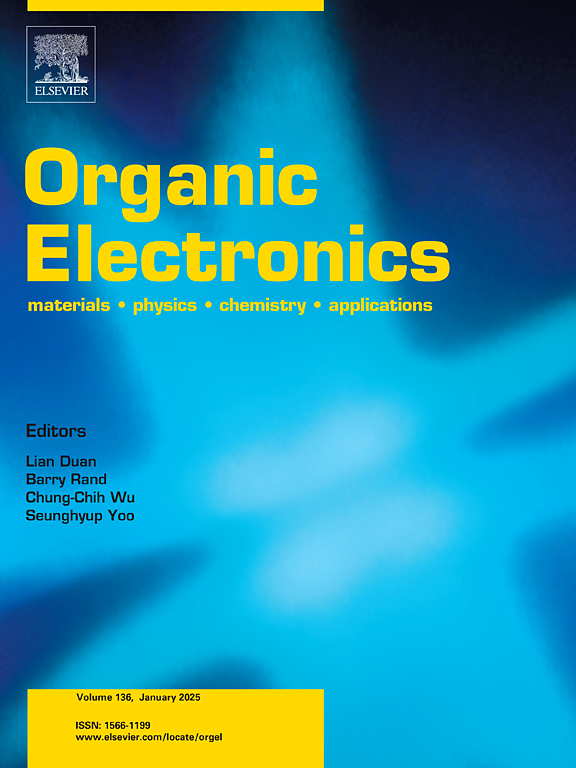有机光电应用中π扩展碳[n]螺旋烯的电荷输运和非线性光学响应的认识
IF 2.6
4区 工程技术
Q3 MATERIALS SCIENCE, MULTIDISCIPLINARY
引用次数: 0
摘要
本研究的目的是研究Chen和Shen(2017)、Xiao等(2021)、Hoffmann(2014)、lisamugeois和Champagne(2012)、Zou等(2021)和Wang等(2019)[7,9,11,13,15,17]helicene的电荷输运和非线性光学(NLO)响应。计算框架DFT/B3LYP/6-311G (d,p)方法在分析helicene系列的光电特性和NLO参数时将重点与计算框架联系起来。利用相同能级的TD-DFT计算模拟了从基态到激发态的吸收特性。吸收最大值(370-465 nm)和能隙(ΔEgap)的数值范围清楚地说明,提供了精确的洞察苯环的热带演代。对所报道的螺旋烯类化合物进行了电离势(ipp)、电子亲和力(E.A.)、重组能(λ)、前沿分子轨道(FMOs)和核无关化学位移(NICS)等评价。计算得到的λh和λe分别在236 ~ 101 meV和247 ~ 213 meV范围内随螺旋烯尺寸的增大而减小。静态和动态第一和第二超极化关系到电荷输运性质(λh <;λe)对潜在NLO光学响应的影响。超极化率在10−24至10−31 esu之间,表明这些碳[n]螺旋烯是先进NLO材料的有希望的候选者。本文章由计算机程序翻译,如有差异,请以英文原文为准。
![Understanding of charge transport and non-linear optical responses into π-extended Carbo[n]Helicenes for organic optoelectronic applications](https://img.booksci.cn/booksciimg/2025-5/102304140291779231009.jpg)
Understanding of charge transport and non-linear optical responses into π-extended Carbo[n]Helicenes for organic optoelectronic applications
The aims of this study is to investigate the charge transport and Non-Linear Optical (NLO) responses of Chen and Shen (2017), Xiao et al. (2021), Hoffmann (2014), Liégeois and Champagne (2012), Zou et al. (2021) and Wang et al. (2019) [7,9,11,13,15,17]Helicenes. The computational framework DFT/B3LYP/6-311G (d,p) methodology ties the highlights to the computational framework in analyzing the optoelectronic properties and NLO parameters of the Helicenes series. The TD-DFT calculations with same level are utilized to mimic the absorption properties from ground to excited state. The numerical ranges for absorption maxima (370–465 nm) and energy gaps () are clearly stated, offering precise insight into the benzene rings chiroptical succession. Ionization potential (I.P.), electron affinity (E.A.), reorganization energies (λ), frontier molecular orbitals (FMOs) and Nucleus Independent Chemical Shift (NICS) are evaluated for the reported Helicenes. The calculated λh and λe decreases with increasing helicene size and ranges from 236 to 101 meV and 247-213 meV, respectively. The static and dynamic first and second hyperpolarizabilities connects the charge transport properties (λh < λe) to the potential NLO optical responses. Hyperpolarizabilities in the order of 10−24 to 10−31 esu, suggest these Carbo [n]Helicenes as promising candidates for advanced NLO materials.
求助全文
通过发布文献求助,成功后即可免费获取论文全文。
去求助
来源期刊

Organic Electronics
工程技术-材料科学:综合
CiteScore
6.60
自引率
6.20%
发文量
238
审稿时长
44 days
期刊介绍:
Organic Electronics is a journal whose primary interdisciplinary focus is on materials and phenomena related to organic devices such as light emitting diodes, thin film transistors, photovoltaic cells, sensors, memories, etc.
Papers suitable for publication in this journal cover such topics as photoconductive and electronic properties of organic materials, thin film structures and characterization in the context of organic devices, charge and exciton transport, organic electronic and optoelectronic devices.
 求助内容:
求助内容: 应助结果提醒方式:
应助结果提醒方式:


